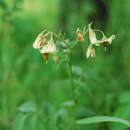Description
provided by Phytokeys (archived)
Woody vining shrub or liana. Stems flexuous, glabrous; new growth minutely pubescent, the trichomes ca. 0.4 mm, simple, uniseriate, later glabrous. Bark of older stems dark reddish brown. Sympodial units plurifoliate. Leaves simple or occasionally very shallowly 3-lobed, 4.5–7 cm long, 3–5 cm wide, ovate to cordate or narrowly cordate, glabrous on both surfaces or with a few minute uniseriate simple trichomes along the midrib above; primary veins 5–7 pairs, drying reddish; base cordate or truncate and oblique; margins entire; apex acuminate; petioles 2.3–3.5 cm long, glabrous, twisting to aid in climbing up supports. Inflorescences leaf-opposed or terminal, 10–30 cm long, ovoid to ellipsoid in overall shape, branching to 5 times, with 50–100 flowers, glabrous; peduncle 1.5–9 cm long, glabrous; pedicels slender, 1.2–1.7 cm long, ca. 0.5 mm in diameter at the base, ca. 1 mm in diameter at the apex, nodding, glabrous, articulated in distal quarter just below the calyx tube leaving an elongate peg, occasionally articulated in the basal half of the pedicel, but always leaving a distinct remnant; pedicel scars widely spaced ca. 1 cm apart, appearing as a series of elongate pegs due to articulation point. Buds globose and somewhat inflated, the corolla strongly exserted from the calyx tube. Flowers all perfect, 5-merous. Calyx tube 3.5–4 mm long (to articulation), the upper part 2–2.5 mm long atop a conical receptacle-like structure, the lobes absent or mere undulations on the rim of the tube, glabrous. Corolla 2–2.3 cm in diameter, purple or violet, stellate, lobed ca. 3/4 of the way to the base, the lobes 0.8–1 mm wide, 0.4–0.6 cm wide, planar (or slightly cupped?) at anthesis, glabrous, the margins and cucullate tips densely papillose. Filament tube < 0.1 mm, glabrous; free portion of the filaments ca. 0.75 mm long; anthers 4–4.5 mm long, 2–2.5 mm wide, stout, poricidal at the tips, the pores lengthening to slits with age. Ovary conical, glabrous; style 0.8–0.9 cm long, glabrous, the stigma capitate, the surface minutely papillose. Fruit a globose berry, 1–1.2 cm in diameter, red when ripe, the pericarp thin and shiny; fruiting pedicels 1.1–1.3 cm long, ca. 0.5 mm in diameter at the base, ca. 1 mm in diameter at the apex, not particularly woody, deflexed, the basal portion of the calyx tube expanding in fruit to be clearly differentiated above the articulation point, appearing somewhat swollen. Seeds ca. 10 per berry, 3–3.5 mm long, 1.5–2 mm wide, flattened reniform, pale brown, the surfaces minutely pitted, the testal cells sinuate in outline. Chromosome number: not known.
- bibliographic citation
- Knapp S (2013) A revision of the Dulcamaroid Clade of Solanum L. (Solanaceae) PhytoKeys 22: 1–432
- author
- Sandra Knapp
Distribution
provided by Phytokeys (archived)
(Figure 23). Known only from Cuba and a single collection from Haiti, at low to middle elevations. Several very old single collections seen from Jamaica (K000196458) and Puerto Rico (Plée s.n., P00549340) may mislabelled as to locality or from cultivated plants.
- bibliographic citation
- Knapp S (2013) A revision of the Dulcamaroid Clade of Solanum L. (Solanaceae) PhytoKeys 22: 1–432
- author
- Sandra Knapp
Solanum cardiophyllum: Brief Summary
provided by wikipedia EN
Solanum cardiophyllum, known as cimatli, the heartleaf horsenettle or heartleaf nightshade, is a North American species, found primarily in Mexico. It is also present in some parts of the SW United States, but was probably introduced. This is one of the few wild potato species that was commonly used as food. The Aztec and the Chichimeca ate S. cardiophyllum and the practice continues in some parts of Mexico today. There was at least one farm that was growing S. cardiophyllum, S. ehrenbergii, and S. stoloniferum for market in Jalisco as recently as 2010.
It is listed as an invasive weed in some parts of the US.
- license
- cc-by-sa-3.0
- copyright
- Wikipedia authors and editors

